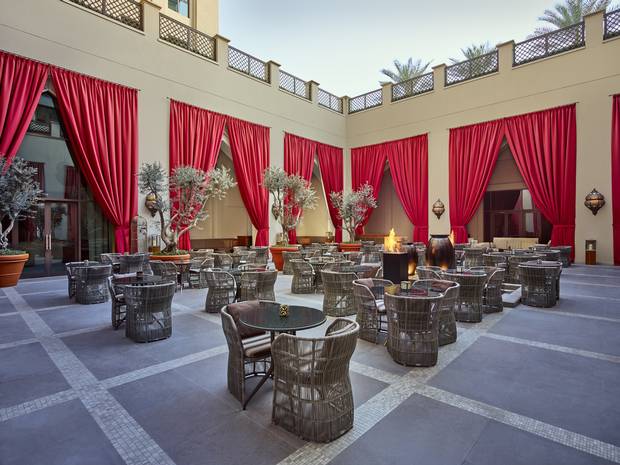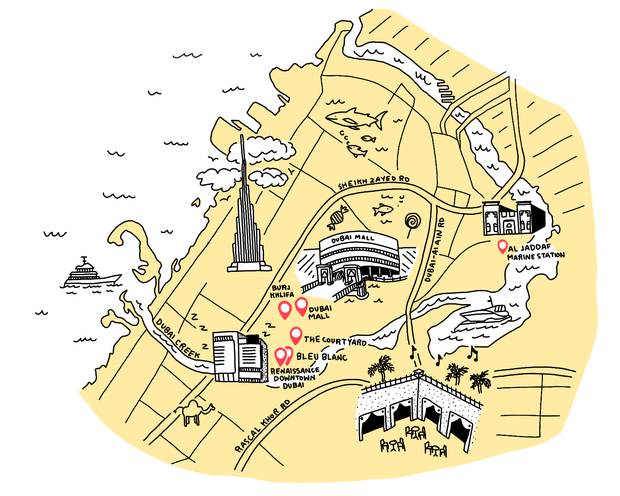The most impressive thing about the Dubai Canal – a 3.2-kilometre waterway that cuts through the city's Business Bay district, flowing to the Persian Gulf from downtown Dubai – is that a little more than a year ago, it was basically just sand.
"I heard they filled it by doing something to the clouds to make it rain," my new friend Felix, a fashion editor from Paris, told me as I marvelled at the wide, curvaceous bay, flanked by sky-high office towers and residential buildings, over breakfast one morning.
His explanation was incorrect; although "cloud seeding," releasing salt into the air to create rain on demand, is actually a thing Dubai is successfully experimenting with, the canal was filled by dredging sand along the coast, allowing some 1.8 million cubic metres of water to flow in from the sea.
But looking out at a futuristic skyline of towers that could have been dropped from the Star Wars city of Coruscant, and sitting blocks from the tallest building in the world and just inland from the largest man-made island on the planet (visible from outer space, it's designed to look like a palm tree when seen from above), I almost believed it myself.
Aside from being an astonishing feat, the creation of the canal is also transforming a neighbourhood of formerly half-built skyscrapers that were more or less abandoned after the 2008 financial crisis into Dubai's most up-and-coming – and pedestrian-friendly – centre. (Although the climate and a dearth of sidewalks generally make it preferable to get around the city by car, the downtown/Business Bay area is one of the few places where you can get from landmark to landmark on foot; winter temperatures that average in the mid-20s [C] – compared with spring and summer temperatures of 40 C and higher – also contribute to the appeal of a stroll this time of year. What's more, because roadways tend to favour meandering, circular routes over directness, walking won't tack on as much time as you'd expect to your journey.)
Eat and drink
Bleu Blanc
Dubai's hotel-dining scene is starting to resemble Las Vegas, given the number of big-name international chefs who've been lured over to open restaurants. Bleu Blanc's executive chef David Myers might not have the same instant name recognition for Canadians as Morimoto or Nobu Matsuhisa, whose eponymous Japanese restaurant is located at Atlantis on the Palm Jumeirah – but one of his former Los Angeles restaurants, Hinoki and the Bird, landed on Bon Appetit and Esquire's best new restaurants lists the year it opened, and the rest of his track record is similarly impressive. At Bleu Blanc, the Michelin-starred chef focuses on Provençal-style classics, such as bouillabaisse and tomato tart with chevre, and wood-fired meats and seafood grilled in an open kitchen. Marasi Drive.
The Courtyard

The Manzil Downtown Hotel offers an extensive menu of shareable Middle Eastern snacks.
Situated in an open-air Arabian-style quad at the Manzil Downtown hotel (hotel restaurants are popular dining options because they're among the few places in Dubai where alcohol is legal), The Courtyard is a relaxed spot for late-night eats – it's open from 5 p.m. till 6 a.m. The menu consists of an extensive list of shareable Middle Eastern snacks, including hummus, tabbouleh, falafel, kofta and manakish, a Lebanese flatbread, as well as shisha, fruit-flavoured tobacco smoked through a glass water pipe. Mohammed Bin Rashid Boulevard.
Stay
Renaissance Downtown Hotel, Dubai
The 298-room Renaissance Downtown Hotel, Dubai has an understated chic style.
Hakan Akdemir
It's easy to lose your sense of place amid Dubai's surreal towers, but the Renaissance Downtown Hotel, Dubai is a stylish, modern tribute to the rolling sand dunes that surround the city. Although opulent glitz tends to be the city's prevailing design ethos, this newly opened 298-room hotel is full of understated chic and cheeky desert-inspired touches, from a hand-blown glass chandelier at the main entryway – running the full length of the lobby, the fixture's golden glass tubes first call to mind a DNA helix, but are meant to evoke undulating mountains of sand – to three-dimensional iron-rod camel sculptures, inspired by one of Picasso's line drawings, and wall-sized close-ups of smiling camels in the guest rooms.
Free-form wooden couches and wavy archway details, which carry up through the elevator area to the guest-room floors, further suggest the shapes and movement of the desert, while a metallic cityscape and raised lounge engulfed by gold chains – a modern play on a traditional Arabic
majlis (seating area) – nod to the city and commerce at the centre of it all. While golden earth tones are maintained throughout the guest rooms, they're punctuated by deep-blue accents that call up the canal. And speaking of: Depending on which side of the hotel you're on, views from the wall-to-wall, floor-to-ceiling windows are of two of the city's most impressive man-made wonders, the canal and the Burj Khalifa.
The rooms are styled in golden earth tones with blue accents.
Handout
Located adjacent to the waterside promenade, the hotel is well positioned for exploring – but with four restaurants, including
Iron Chef star Masaharu Morimoto's first UAE outpost, a speakeasy cocktail bar, open-air shisha lounge overlooking the bay, infinity pool, gym and, opening in early 2018, a Six Senses spa, where each suite offers an experience designed to stimulate a particular sense, reserve some time for enjoying the property. From 799 Emirati dirhams (about $270 Canadian) a night.
Experience
The Dubai Canal
With a 12-kilometre bike path, 3-km running track and pedestrian promenade, the canal is great for getting outside and taking in the spectacular skyline; ferry service from Jumeirah to Al Jaddaf Marine Station in the Dubai Creek (from 15 dirhams, or about $5, depending on the distance) provides access to some of downtown's farther-flung attractions (with cafés, galleries and concept shops, the Dubai Design District is a worthy stop). Stop by the Sheikh Zayed Road bridge from 8 to 10 p.m., when the waterfalls are illuminated.
Burj Khalifa
Clocking in at more than 828 metres and 160 storeys, the Burj Khalifa is the world's tallest building, with a design inspired by desert flowers and traditional Islamic architecture.
A ride up to the observation deck on the 148 th floor starts at 350 dirhams ($125; located on Levels 124 and 125), but it's free with your food and drink if you head up to At.mosphere, a restaurant and lounge on the 122nd floor that's accessible via the Armani Hotel. Reservations recommended.
Dubai Mall
Equivalent in size to 200 soccer fields, the Dubai Mall is the largest in the world by total area. And while there are more than 1,200 retailers inside, attractions also include a 10-million-litre aquarium that holds more than 300 sharks and rays; an Emirates A380 flight simulator; KidZania, a child-sized interactive city; skating rink, 155-million-year-old dinosaur bones, art exhibits and more. If you have a sweet tooth, make sure to stop into Candylicious for the most epic sugar high of your life: The 10,000-square-foot emporium stocks more than 5,000 varieties of candy and chocolate.
The writer travelled as a guest of the Renaissance Downtown Hotel, Dubai. It did not review or approve this article.

